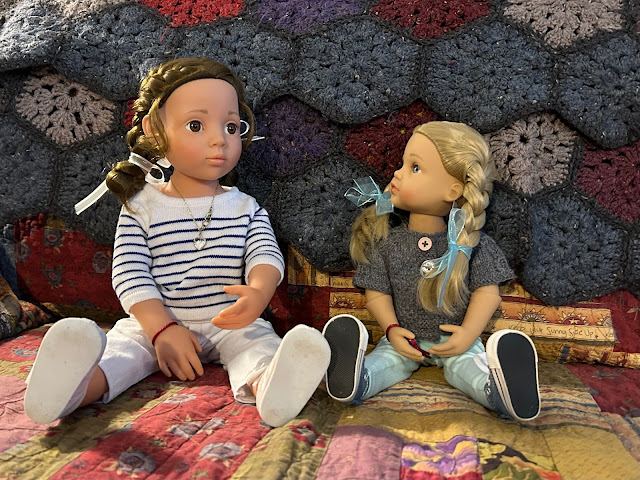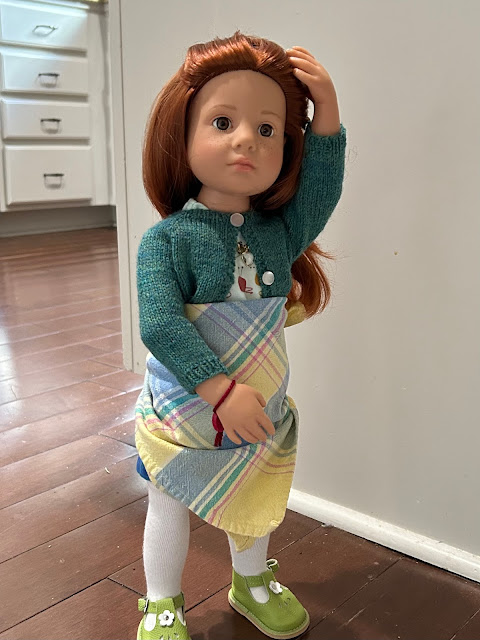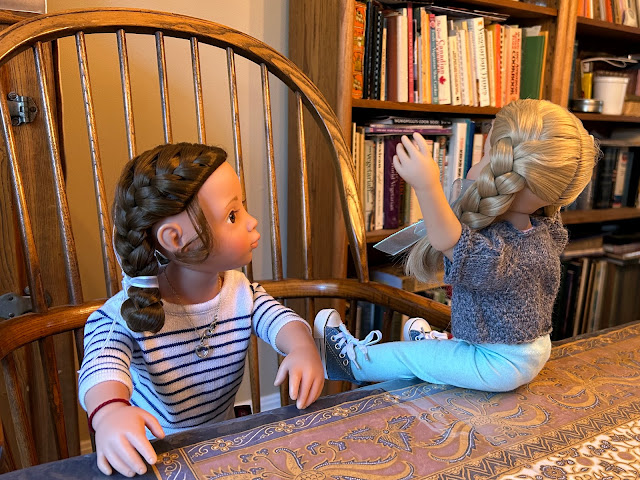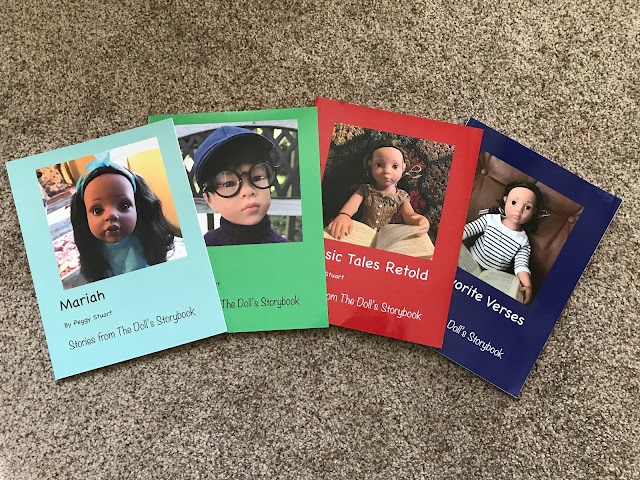Veronika wasn’t surprised to see Nico coming up the walk to the front door, as he often comes to visit, but he had someone with him: a smaller doll, someone Veronika didn’t recognize.
She listened for his knock. After it came, she heard voices downstairs.
As Veronika made her way down the stairs, Mandy was letting Nico and his companion in through the front door.
Veronika thought Nico looked happy to see that she was there. Not happy, exactly…relieved. Nico, who was taking off his jacket, was relieved that she was home.
“Hi, Nico,” Veronika said, as Mandy took the dolls’ jackets to leave in the hallway and then continued to the kitchen, where she had been helping Jolena bake some cookies.
Nico realized that introductions were called for. “Veronika, this is Pam,” he said politely. He knew how to do this, because he had watched Frankie’s mother teach him how to do it.
Then he turned to his companion. “Pam,” he said, “this is Veronika. She’s the one I told you about. I think you can tell her everything and she will help.”
Nico turned to Veronika again, “I met Pam yesterday. Frankie took me when he went with his father to talk to a neighbor about plowing their driveway when the snow comes. The neighbor’s daughter got Pam for Christmas.”
“How exciting!” Veronika exclaimed. “It’s so nice to have new dolls in the neighborhood.” As she said this, she realized that Pam didn’t look all that happy. “You are glad to be here, aren’t you?” she asked.
“That’s why I wanted Pam to talk to you,” Nico said. Then he turned to Pam. “I’ll just wait upstairs in the workroom,” he told her.
“Most of the others are there,” Veronika told him. “I’m sure they would be happy to see you.”
With a look at Pam to make sure she was OK with Veronika, Nico headed off to the stairs. By the time he was a couple of steps up––Nico is slow going up the stairs, because he doesn’t have elbow and knee joints––Veronika and Pam had already settled down on the couch.
“So you were a Christmas present,” Veronika said. “I can imagine you were glad to have them let you out of the box.” She had seen a lot of dolls get removed from the boxes they had been in since they were made in the factory, so she knew a thing or two about it.
“Oh, yes!” Pam agreed. “I was very relieved and excited, and Maryanne is a nice girl. She already had some clothes for me, and she washed my hair and then braided it when it was dry. I like having braids.”
“Something’s the matter, though, isn’t it?” Veronika asked, because Pam still looked a bit sad.
“Yes,” Pam replied. “I know I’m supposed to help the child I live with learn to look after others. I’m supposed to set a good example for her and help her with her troubles, but I don’t seem to be doing that very well. She seems unhappy.”
“Do you know what she’s unhappy about?” Veronika asked.
“Yes,” Pam said. “Her family found out right before Christmas that Maryanne has a disease called diabetes (dy-ah-BEET-eez). She has to be careful about her diet and needs to take medication from a needle every day.”
“That must be difficult for her,” said Veronika, who knew that children don’t like to be poked with needles.
“It’s bad enough,” Pam agreed, “but what bothers her the most is that she thinks she did something to cause it. She’s unhappy that she’s making her parents worry about her. I want to help, but I don’t know what to do.”
Veronika thought for a moment. Then she gave Pam a pat. “Well, we can help you feel better, and maybe Maryanne, too.” she told the younger doll. “First of all, you’re right that we’re supposed to teach children how to care about others, set a good example for them and help them with their troubles. You’re already working on that, but it sometimes takes time. We can’t make human people’s troubles stop happening. All we can do is listen, comfort and guide them.”
Then Veronika asked Pam if Maryanne hears her. “Sometimes it takes awhile for a child to hear what dolls are saying,” she pointed out. “You listen to Maryanne when she talks to you, but she may not hear you when you talk to her.”
“I don’t think she does,” Pam said. “Hear me, I mean.”
“Well,” Veronika, “we dolls have a little trick we can use to teach human children how to hear us.”
“We wait until they go to sleep at night,” Veronika continued. “Then we sit by them and talk to them. If we make up stories for them, we can give them happy dreams. We can talk to them, and they can listen in their sleep. They may not remember the next day, but if they have any imagination at all, eventually they will hear us when we talk to them during the day.”
“That would be wonderful!" Pam exclaimed. “I’ll start tonight!”
Veronika was still thinking. “Now,” she said, “we need to figure out what Maryanne needs to hear from you.”
After nearly a minute of thinking, Veronika shook her head. “I don’t know much about diabetes, but I’ll bet Mandy does. Maybe she can help us.” Veronika looked toward the kitchen. “Mandy?” she called. “I think we could use your help.”
A few seconds later, Mandy appeared in the doorway to the kitchen, wiping her hands on the cloth napkin she was using as an apron. “What do you need?” she asked. “I’m done now. Jolena is just putting the cookies in the oven, and she can take them out when the timer goes off.”
“What do you know about diabetes?” Veronika asked her sister.
Mandy thought for a moment. “Well,” she said, “I know it’s a condition human people can have where their bodies don’t make something called insulin (IN-suh-lin), or they don’t make enough of it. Humans need insulin to help them use something called glucose (GLU-kose), which is a kind of sugar. Some humans have to take insulin by injection (in-Jek-shun). That’s a kind of shot. The insulin has to be put into their bodies using a needle. They also need to have their blood tested to find out how much of this sugar they have in their blood.”
Veronika knew Mandy would know! “The human child Pam lives with is diabetic and blames herself. Can a human child cause themselves to be diabetic?” she asked then.
“I don’t know,” Mandy replied. “Let’s find out!” She gestured toward the table, where The Writer’s laptop is often sitting open, unless the family is eating.
Mandy climbed up to the table and had a look at the laptop to see if The Writer had something she was working on. (She didn't want to mess up The Writer’s work.) It was on, but nothing was running. There was nothing on the screen but the picture of Jolena from summer ski practice. Mandy knew that was something called wallpaper, a photo The Writer chose to show on the screen when the computer wasn't busy. She pulled out her glasses from her skirt pocket and put them on, so she could read.
“I’ll pick a website that belongs to one of the big medical centers,” Mandy said. “If you just look something up online, you can get all kinds of answers that might be correct or not.”
“This website is reliable,” she said. “Now give me a minute or two to read.”
Mandy is a fast reader, and it didn’t take her long to find what she was looking for. “It says that diabetes usually runs in families,” she told them. “That means that the possibility for a human to have it is something they are born with.” Mandy looked at Pam, “That’s like they come out of the factory already with the possibility of having it,” she added.
Mandy continued to read. “Oh, look at this!” she exclaimed. “It says children often blame themselves for having diabetes or think that they are being punished for something by having it.”
“That’s what Maryanne’s doing!” Pam exclaimed.
“It isn’t something she could help,” Mandy said, “and it isn’t her fault, but she can do a lot to help her parents keep her healthy with diet and exercise. Eventually, she will need to learn to test her body for sugar herself and to give herself insulin.”
“That’s where you come in, Pam,” Veronika said. “Now you know what to do, but don’t get discouraged if it takes a while to get Maryanne to hear you. Not all human people know how to use their imaginations. It helps that Maryanne is still a child.”
“I’m so excited!” cried Pam. “I spent months in my box. I learned to be patient. I’ll keep working to get Maryanne to hear me if it takes months and months!”
Just then the front door opened. Pippa and Pauly had come back from playing at the park.
“We have a new neighbor,” Veronika called out to them. “Come and meet Pam!”
Then the dolls heard a “ding” from the timer in the kitchen. The cookies were ready! Jolena would take care of them.
Veronika: Götz Classic Kidz Vroni
Mandy: Götz Happy Kidz Katie 2015
"The Doll's Storybook" is not affiliated with Gotz Dolls USA Inc. or Götz Puppenmanufaktur International GmbH.
Watch for the next story each Friday afternoon at 1:00 PM Pacific Time.
<a href="https://www.bloglovin.com/blog/19832501/?claim=j3fj3mbb8kt">Follow my blog with Bloglovin</a>
Copyright © 2024 by Peggy Stuart















































What a lovely understanding story.
ReplyDelete